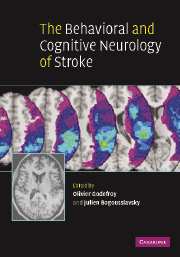Book contents
- Frontmatter
- Contents
- Contributors
- Preface
- 1 Evaluation of cognitive and behavioral disorders in the stroke unit
- Motor and gestural disorders
- Aphasia and arthric disorders
- Hemineglect, Anton–Babinski and right hemisphere syndromes
- Agnosia and Bálint's syndrome
- Executive and memory disorders
- Behavioral and mood disorders
- Dementia and anatomical left/right syndromes
- 31 Vascular dementia
- 32 Right versus left hemisphere syndromes
- Index
- References
32 - Right versus left hemisphere syndromes
Published online by Cambridge University Press: 10 October 2009
- Frontmatter
- Contents
- Contributors
- Preface
- 1 Evaluation of cognitive and behavioral disorders in the stroke unit
- Motor and gestural disorders
- Aphasia and arthric disorders
- Hemineglect, Anton–Babinski and right hemisphere syndromes
- Agnosia and Bálint's syndrome
- Executive and memory disorders
- Behavioral and mood disorders
- Dementia and anatomical left/right syndromes
- 31 Vascular dementia
- 32 Right versus left hemisphere syndromes
- Index
- References
Summary
Introduction
Although the brain is a symmetrical organ, its functional architecture is rather asymmetric. Beyond a certain degree of functional hierarchy, there is a lateralized distribution of cerebral functions, each hemisphere being dominant for a specific type of information processing. This functional asymmetry is evident in the association and multimodal cortices and extends to the subcortical networks.
The mechanisms of hemispheric specialization are not completely understood. Yet, there is converging evidence that the phenomenon of cerebral dominance is based on hemispheric differences in cortical cytoarchitecture and inter-area connectivity that create neural networks with specific styles of information processing (Hustler and Galuske, 2003). Innate computational differences between the two hemispheres are likely to be enhanced or modulated by experience, function acquisition (Gaillard et al., 2003; Castro-Caldas et al., 1998), timing of brain maturation, as the development of the right hemisphere precedes the development of the left (Chiron et al., 1997), and by the degree of expertise achieved in specific functions (Tatsuno and Sakai, 2005; Pascual-Leone et al., 1994). Neurochemical asymmetries may also explain some aspects of behavior (Mohr et al., 2003).
The left cerebral hemisphere is characterized by a discreet organization of functions and a rather sequential, linear, and analytic processing style. This is probably responsible for its ability to extract and process perceptual detail (Delis et al., 1988) and for its advantage in the temporal resolution of events (Zatorre & Belin, 2001), such as the rapidly changing speech sounds.
- Type
- Chapter
- Information
- The Behavioral and Cognitive Neurology of Stroke , pp. 617 - 636Publisher: Cambridge University PressPrint publication year: 2007
References
- 2
- Cited by



